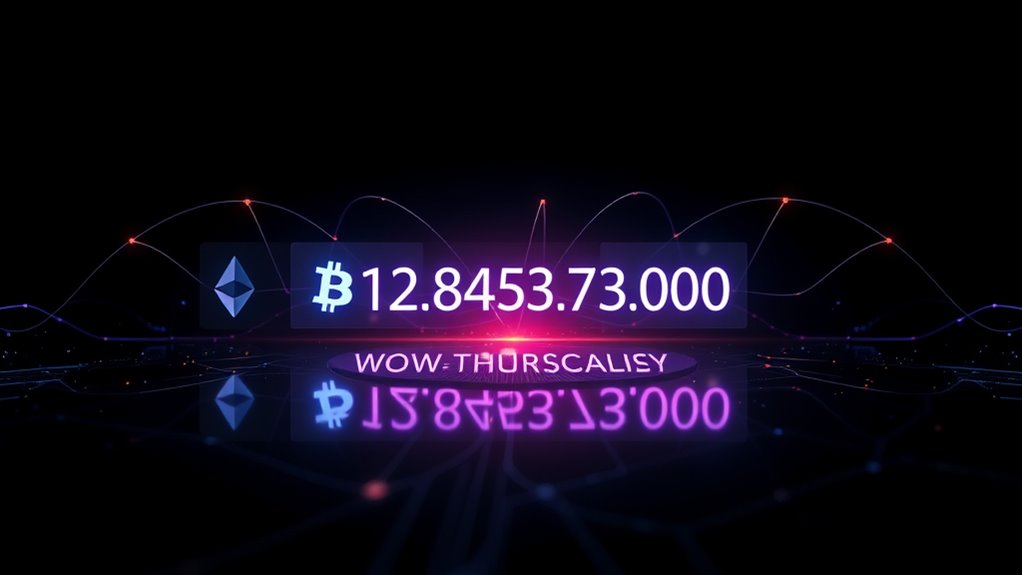Unified wallets aim to let you manage assets across multiple blockchains with a single address, making access more straightforward and reducing the hassle of managing multiple wallets. However, they face significant technical and security challenges, like limited cross-chain communication and risks from vulnerabilities. True interoperability isn’t fully achievable yet, and third-party bridges can introduce dangers. If you want to understand how these hurdles are being addressed and what the future holds, keep exploring the topic.
Key Takeaways
- Unified wallets aim to manage multiple cryptocurrencies with a single address, simplifying multi-chain asset access.
- True one-address solutions across all chains are limited due to differing blockchain architectures and standards.
- Interoperability challenges hinder seamless asset transfer and management on a single address across multiple chains.
- Security risks increase with multi-chain management, making a single address potentially vulnerable if compromised.
- Current solutions often rely on third-party bridges, which may not support all assets or provide full cross-chain integration.

Have you ever wished for a simpler way to manage multiple digital assets? If you’re juggling various cryptocurrencies across different blockchains, a unified wallet might seem like the perfect solution. The idea of having one address that works seamlessly across all chains sounds incredibly convenient. But before diving in, it’s important to understand some of the hurdles, especially concerning interoperability challenges and security concerns. These issues are at the core of whether a unified wallet can truly deliver on its promise.
Interoperability challenges are one of the biggest obstacles facing unified wallets. Each blockchain has its own architecture, protocols, and standards, which makes creating a single, universal address complex. Many blockchains operate in silos, with limited ways to communicate or transfer assets directly between them. This fragmentation means that a wallet designed to work across multiple chains must either rely on third-party bridges or layered solutions, which introduce their own complications. These bridges often require multiple steps to move assets from one chain to another, defeating the purpose of having a unified address. Additionally, not all assets are supported equally, and some networks may lack the infrastructure to integrate smoothly with others. As a result, achieving true interoperability remains a significant technical challenge, and many unified wallets still rely on convoluted solutions that can be confusing for users.
Interoperability hurdles hinder seamless cross-chain asset transfers and complicate unified wallet adoption.
Security concerns also loom large when considering a unified wallet. Managing multiple assets across different chains increases the risk of vulnerabilities. Because these wallets often need to connect to various blockchain networks, they become attractive targets for hackers. The more complex the system, the more potential entry points exist for malicious actors. If a single private key is used across multiple chains, a compromise on one network could jeopardize assets stored elsewhere. Furthermore, the reliance on third-party bridges or interoperability layers can introduce additional security risks. These components may have bugs, exploits, or vulnerabilities that hackers can exploit, leading to potential theft or loss of funds. For users, this means that while the convenience of a unified wallet is appealing, it often comes with a trade-off — the need to weigh the simplicity against the heightened security risks. Recent advancements in blockchain security are aiming to mitigate some of these vulnerabilities, but the risks are still present.
In essence, while the idea of managing all your digital assets with one address across multiple chains is enticing, the reality is more complicated. Interoperability challenges hinder seamless integration, and security concerns demand careful consideration. Before adopting a unified wallet, you should evaluate whether the convenience outweighs the potential vulnerabilities. Staying informed about the latest developments and choosing reputable solutions can help you navigate these hurdles more safely. Ultimately, a unified wallet’s success depends on ongoing innovations that address these core issues, making it an exciting but still evolving space in digital asset management.
Frequently Asked Questions
How Secure Are Unified Wallets Against Hacking?
Unified wallets simplify managing multiple cryptocurrencies, but their security depends on various factors. You could be vulnerable to hacking if they lack robust intrusion detection systems and effective phishing prevention measures. Always use strong, unique passwords and enable two-factor authentication. Be cautious of phishing attempts targeting your wallet details. Regularly updating your software and monitoring account activity helps protect your assets, ensuring your unified wallet remains secure against potential threats.
Can I Recover My Wallet if I Forget the Password?
If you forget your wallet password, you’ll want to explore your backup options for password recovery. Many wallets offer recovery phrases or seed backups that let you restore access. Without these, regaining access can be impossible. Always guarantee you securely store your backup options, like seed phrases or recovery keys, and check if your wallet supports password recovery features to avoid losing access permanently.
Do Unified Wallets Support All Blockchain Networks?
Not all wallets support every blockchain network, but many aim for cross chain interoperability through wallet standardization. This means some unified wallets can connect to multiple chains, but coverage varies. You should check if the wallet supports the specific blockchains you’re interested in, since full support isn’t universal yet. As the industry grows, more wallets will likely offer broader cross chain interoperability, making multi-network access easier.
How Do Transaction Fees Vary Across Different Chains?
Transaction fees vary across different chains due to factors like gas fees and network congestion. On some chains, you pay higher fees during peak times, which can also slow down transaction speed. Other chains offer lower fees and faster processing, depending on their consensus mechanisms. You should check each chain’s current network conditions to understand how gas fees and transaction speed might impact your transactions.
Are Unified Wallets Compatible With Hardware Wallets?
Unified wallets can be compatible with hardware wallets if they meet strict cryptographic standards and support secure hardware integration. You need to verify the unified wallet software works seamlessly with your hardware device, enabling safe transactions across different chains. Look for wallets that prioritize security features and hardware compatibility, allowing you to manage multiple cryptocurrencies securely with hardware integration, while maintaining the cryptographic standards necessary for safe, reliable operations.
Conclusion
Unified wallets could simplify your crypto experience by giving you one address across multiple chains. This means easier management, quicker transactions, and less confusion. While the technology is still evolving, adopting a unified wallet might soon become the norm, saving you time and effort. Stay tuned and consider trying one out—you might find it streamlines your digital assets like never before. Embrace the future of seamless, cross-chain crypto management.









